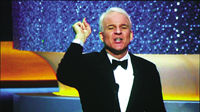Now That's Television Page 3
How It Looked and Sounded
Unlike my solo performance for the Grammys, I invited three other couples and their kids over to watch the Oscars and fill up on popcorn, soda, and candy. I used the same A/V system, with the exception of a new receiver: NAD's T752 replaced the Sony and drove the five Snell speakers.
 First of all, the picture quality was outstanding. Until now, there haven't been many opportunities to see what live 720p looks like, other than the 720p clips that ABC has provided to CES exhibitors over the past few years. The Oscars showed what newer progressive-scan cameras can do with high-resolution images. (Can you wait until Monday Night Football returns in HD this September?)
First of all, the picture quality was outstanding. Until now, there haven't been many opportunities to see what live 720p looks like, other than the 720p clips that ABC has provided to CES exhibitors over the past few years. The Oscars showed what newer progressive-scan cameras can do with high-resolution images. (Can you wait until Monday Night Football returns in HD this September?)
My local ABC affiliate (WPVI-DT) held up their end of the bargain with a near-flawless transmission. The only mishap was a loud thump at one point, which ABC believes may have been caused when an LAPD helicopter flew in front of their satellite uplink. Apparently, the transmission wasn't as great in the Los Angeles area, though. I received more than one report that the signal from KABC-DT intermittently froze up and dropped out during the show, which was most likely caused by a problem with their encoder. Yes, there are still ghosts in the DTV machine from time to time.
Host Steve Martin was at the top of his game and kept things focused, as did the orchestra members, who were under strict orders to follow a 45-second speech limit and make sure that the Oscar winners didn't slow down the show too much. Even so, the show still ended just after midnight on the East Coast. Again, the sets and the Kodak Theatre's interior dcor just cried out for HDTV.
ABC made good use of numerous camera angles to convey a sense of the Oscar sets' size and sweep. In fact, the stage looked as if it had originally been designed for a 16:9 aspect ratio. The large Oscar statues inside and outside of the theater had quite a sheen, while the stage sets looked very complex. There were also plenty of stylish graphics and logos that worked well for both the 16:9 and 4:3 aspect ratios.
ABC had a few HD cameras working the crowds, sitting next to such actors as Richard Gere, Adrien Brody, and Salma Hayek. There was a strong sense of intimacy, like you were sitting right there with the black-tie set. The close-up HD shots were particularly effective when the winners heard their names announced. I won't soon forget Adrien Brody laying a big smooch on Halle Berry at the lectern. Kirk and Michael Douglas hamming it up during the Best Picture presentation was classic TV.
 The sound mix wasn't as immersive as that provided for the Grammys, but it didn't need to be. After all, this was an auditorium mix. If you sat very close to the stage, you'd no doubt have heard the winners making their speeches at the center microphone. The rest of the Kodak Theatre audience was listening to a traditional stereo mix, though, and that's what we got at home. The surrounds kicked in only with applause and natural reverb from the orchestra.
The sound mix wasn't as immersive as that provided for the Grammys, but it didn't need to be. After all, this was an auditorium mix. If you sat very close to the stage, you'd no doubt have heard the winners making their speeches at the center microphone. The rest of the Kodak Theatre audience was listening to a traditional stereo mix, though, and that's what we got at home. The surrounds kicked in only with applause and natural reverb from the orchestra.
What did the Academy think of the HD-cast? "ABC had wanted to do the Oscars in HD for some time," said Ric Robertson, executive administrator of AMPAS. "From our early discussions, we looked to Tad and asked, €˜Could this be done?' This show is so big in terms of cameras and equipment€is there the infrastructure to pull this off?"
He added, "One of the concerns we had with a dual-truck production was that there had to be a whole redundant system of cameras. We already had to kill a number of seats in the theater to free up camera space." Of course, that wasn't necessary with a single production truck. "From our perspective, it worked. We're very happy with how it turned out, and we'll continue to produce the Oscars this way in the future."
- Log in or register to post comments

























































